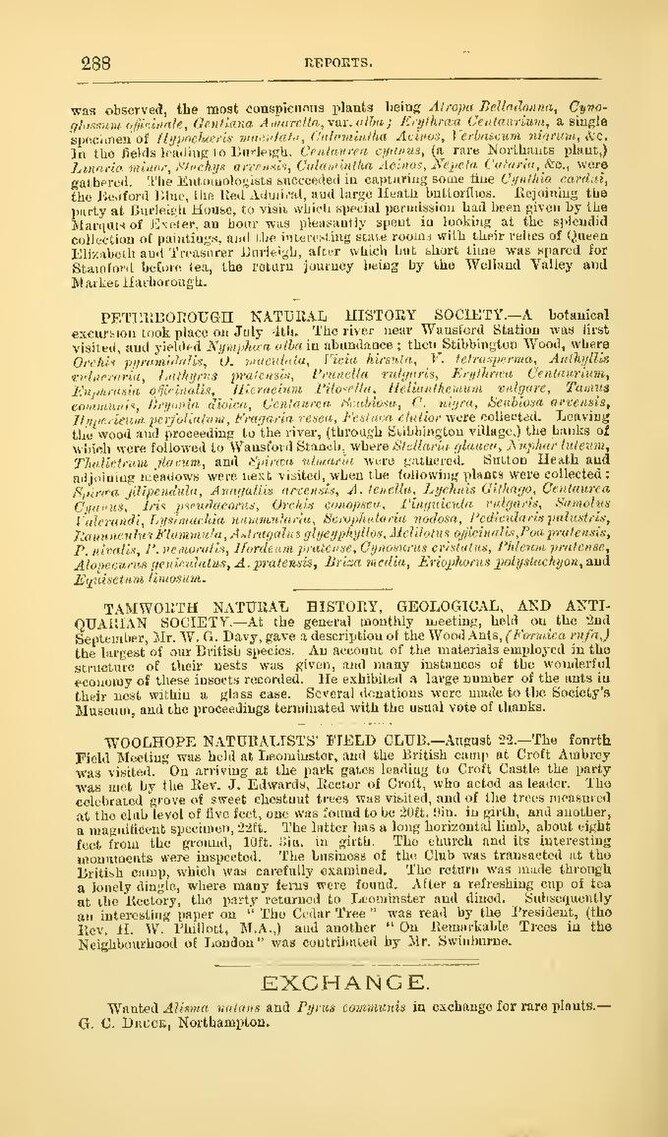was observed, the most conspicuous plants being Atropa Belladonna, Cynoglossum officionale, Gentiana Amarella, var. alba; Erythræa Centaurium, a single specimen of Hypochæris maculata, Calamintha Acinos, Verbascum nigrum &c. In the fields leading to Burleigh, Centaurea cyanus, (a rare Northants plant, Lanaria minor, Stachys arrensis, Calamintha Acinos, Nepeta Cataria, &c., were gathered. The Entomologists succeeded in capturing some fine Cynthia cardai, the Bedford Blue, the Red Admiral, and large Heath butterflies. Rejoining the party at Burleigh House, to visit which special permission had been given by the Marquis of Exeter, an hour was pleasantly spent in looking at the splendid collection of paintings, and the interesting state rooms with their relics of Queen Elizabeth and Treasurer Burleigh, after which but short time was spared for Stainford before tea, the return journey being by the Welland Valley and Market Harborough.
Peterborough Natural History Society.—A botanical excursion took place on July 4th. The river near Wansford Station was first visited, and yielded Nymphæa alba in abundance; then Sttibington Wood, where Orchis pyramidalis O. punctata, Vicia hirsuta, V. tetrasperma, Anthyllis vulneraria, Lathyrus pratensis, Prunella vulgaris, Erythræa Centaurium, Euphrasia officinalis, Hypericum perforatum, Fragaria vesca, Festuca elatior were collected. Leaving the wood and proceeding to the river, (through Stibbington village,) the banks of which were followed to Wansford Stanch, where Stellaria glauca, Nuphar leuteum, Thalictrum flavum, and Spiræa ulmaria were gathered. Sutton Heath and adjoining meadows were next visited, when the following plants were collected: Spiræa filipendula, Anagallis arvensis, A. tenella, Lychnis Githago, Centaurea Cyanus, Iris pseudacorus, Orchis conopsea, Pinguicula vulgaris, Samolus Valerandi, Lysimachia nummularia, Scrophularia nodosa, Pedicularis palustris, Ranunculus Flammula, Astragalus glycyphyllos, Melilotus Officinalis, Poa pratensis, P. nivalis, P. nemoralis, Hordeum pratense, Cynosurus cristatus, Phleum pratense, Alopecurus geniculatus, A. pratensis, Briza media, Eriophorus polystachyon, and Equisetum limosum.
Tamworth Natural History, Geological, and Antiquarian Society.—At the general monthly meeting, held on the 2nd September, Mr. W. G. Davy, gave 4, description of the Wood Ants, (Formica rufa) the largest of our British species. An account of the materials employed in the structure of their nests was given, and many instances of the wonderful economy of these insects recorded. He exhibited a large number of the ants in their nest within a glass case. Several donations were made to the Society's Museum, and the proceedings terminated with the usual vote of thanks.
Woolhope Naturalists Field Club.—August 22—The fourth Field Meeting was held at Leominster, and the British camp at Croft Ambrey was visited. On arriving at the park gates leading to Croft Castle the party was met by the Rev. J. Edwards, Rector of Croft, who acted as leader. The celebrated grove of sweet chestnut trees was visited, and of the trees measured at the club level of five feet, one was found to be 20ft. 9in. in girth, and another, a magnificent specimen, 22ft. The latter has a long horizontal limb, about eight feet from the ground, 10ft. 3in. in girth. The church and its interesting monuments were inspected. The business of the Club was transacted at the British camp, which way carefully examined, he return was made through a lonely dingle, where many ferns were found. After a refreshing cup of tea at the Rectory, the party returned to Leominster and dined. Subsequently an interesting paper on "The Cedar Tree" was read by the President, (the Rev. H. W. Phillott, M.A.) and another "On Remarkable Trees in the Neighbourhood of London" was contributed by Mr. Swinburne.
Exchange.
Wanted Alisma natans and Pyrus communis in exchange for rare plants.—G. C. Druce, Northampton.
